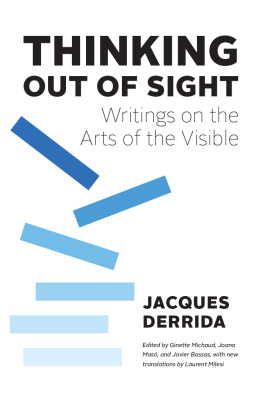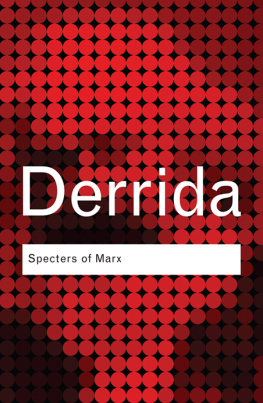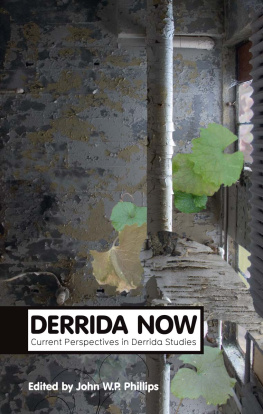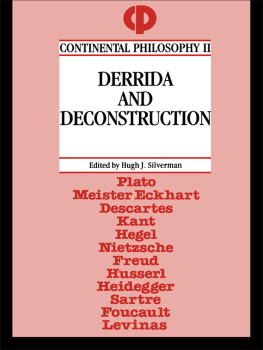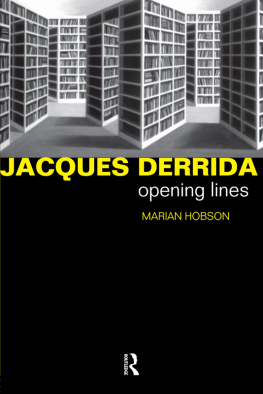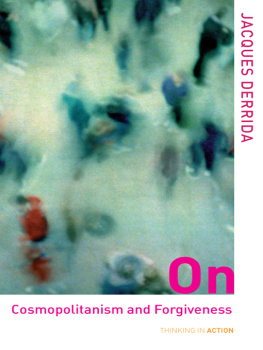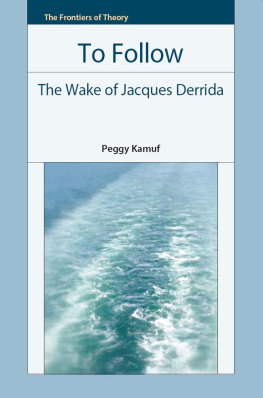Jacques Derrida - Thinking Out of Sight: Writings on the Arts of the Visible
Here you can read online Jacques Derrida - Thinking Out of Sight: Writings on the Arts of the Visible full text of the book (entire story) in english for free. Download pdf and epub, get meaning, cover and reviews about this ebook. year: 2021, publisher: University of Chicago Press, genre: Science. Description of the work, (preface) as well as reviews are available. Best literature library LitArk.com created for fans of good reading and offers a wide selection of genres:
Romance novel
Science fiction
Adventure
Detective
Science
History
Home and family
Prose
Art
Politics
Computer
Non-fiction
Religion
Business
Children
Humor
Choose a favorite category and find really read worthwhile books. Enjoy immersion in the world of imagination, feel the emotions of the characters or learn something new for yourself, make an fascinating discovery.
- Book:Thinking Out of Sight: Writings on the Arts of the Visible
- Author:
- Publisher:University of Chicago Press
- Genre:
- Year:2021
- Rating:3 / 5
- Favourites:Add to favourites
- Your mark:
- 60
- 1
- 2
- 3
- 4
- 5
Thinking Out of Sight: Writings on the Arts of the Visible: summary, description and annotation
We offer to read an annotation, description, summary or preface (depends on what the author of the book "Thinking Out of Sight: Writings on the Arts of the Visible" wrote himself). If you haven't found the necessary information about the book — write in the comments, we will try to find it.
Thinking Out of Sight: Writings on the Arts of the Visible — read online for free the complete book (whole text) full work
Below is the text of the book, divided by pages. System saving the place of the last page read, allows you to conveniently read the book "Thinking Out of Sight: Writings on the Arts of the Visible" online for free, without having to search again every time where you left off. Put a bookmark, and you can go to the page where you finished reading at any time.
Font size:
Interval:
Bookmark:

THE FRANCE CHICAGO COLLECTION
A series of books translated with the generous support of the University of Chicagos France Chicago Center
Jacques Derrida
Edited by Ginette Michaud, Joana Mas, and Javier Bassas
With new translations by Laurent Milesi
The University of Chicago Press
CHICAGO & LONDON
The University of Chicago Press, Chicago 60637
The University of Chicago Press, Ltd., London
2021 by The University of Chicago
All rights reserved. No part of this book may be used or reproduced in any manner whatsoever without written permission, except in the case of brief quotations in critical articles and reviews. For more information, contact The University of Chicago Press, 1427 E. 60th St., Chicago, IL 60637.
Published 2021
Printed in the United States of America
30 29 28 27 26 25 24 23 22 21 1 2 3 4 5
ISBN-13: 978-0-226-14061-2 (cloth)
ISBN-13: 978-0-226-59002-8 (e-book)
DOI: https://doi.org/10.7208/chicago/9780226590028.001.0001
Library of Congress Cataloging-in-Publication Data
Names: Derrida, Jacques, author. | Michaud, Ginette, 1955 editor. | Mas, Joana, editor. | Bassas, Javier, editor. | Milesi, Laurent, translator.
Title: Thinking out of sight : writings on the arts of the visible / Jacques Derrida ; edited by Ginette Michaud, Joana Mas, and Javier Bassas ; with new translations by Laurent Milesi.
Other titles: Writings on the art of the visible
Description: Chicago ; London : The University of Chicago Press, 2021. | Includes bibliographical references and index.
Identifiers: LCCN 2020028197 | ISBN 9780226140612 (cloth) | ISBN 9780226590028 (ebook)
Subjects: LCSH: Derrida, JacquesInterviews. | ArtPhilosophy. | ArtsPhilosophy. | Philosophy, French20th century.
Classification: LCC N67 .D4713 2021 | DDC 700.1dc23
LC record available at https://lccn.loc.gov/2020028197
 This paper meets the requirements of ANSI / NISO Z39.48-1992 (Permanence of Paper).
This paper meets the requirements of ANSI / NISO Z39.48-1992 (Permanence of Paper).
For three decades, the arts have been one of the privileged sites of Derridean deconstruction. From The Truth in Painting (with Valerio Adami and Grard Titus-Carmel, orig. 1978) to the exhibition Memoirs of the Blind (which was curated by Jacques Derrida at the Louvres Cabinet des Arts Graphiques in 1990); from the Reading of Right of Inspection (with Marie-Franoise Plissart, orig. 1985) to Athens, Still Remains (with Jean-Franois Bonhomme, orig. 1996); from Lignes in Mille e tre, cinq (with Micala Henich, orig. 1996) to Atlan grand format (with Jean-Michel Atlan, orig. 2001), La connaissance des textes (with Simon Hanta and Jean-Luc Nancy, orig. 2001) and Artaud the Moma (orig. 2002), Derrida has elaborated and problematized the philosophical notion of visibility in a close dialogue with predominantly contemporary artistic productions.
The visible is for Derrida the site of a fundamental opposition between the sensible and the intelligible, night and day, light and shadow. It builds on all the values of ontological and phenomenological appearingphenomenon (phainesthai), theory (therein), evidence, clarity or truth, unveilingwhich institute a strong philosophical hierarchy of the senses. Consequently, the visible is denounced by Derrida whenever this privilege of optics is posed as the question commanding the whole history of Western metaphysics.
In the gesture performed by deconstruction, the so-called visual arts play an important role not only in interrogating the history of philosophy proper but also in allowing one to think the visible as articulated by the movement of the trace and diffrance, both Derridean figures of writing. Such a displacement of the visible toward the written is at the heart of the Derridean interrogation in all the texts gathered here under this title: not the visual arts but arts of the visible. These arts of the visible are, in deconstruction, deeply invested by the very movement of writing since, as Derrida puts it, even if there is no discourse, the effect of spacing already implies a textualization. For this reason, the expansion of the concept of text is strategically decisive here. So the works of art that are the most overwhelmingly silent cannot help but be caught within a network of differences and references that give them a textual structure.
Thus, in the margins of the books and catalogues that he has devoted to artists works, Derrida has increasingly paid attention to the arts. Alongside this more theoretical work, the philosopher has also collaborated on many occasions with artists, as well as taken part in gatherings, roundtable discussions, and interviews with architects, art historians, aestheticians, and film critics. Derridas reflection on drawing, painting, photography, cinema, video installation, and the theater starts taking shape especially from the 1980s onward, in several French and foreign journals (Annali, Beaux Arts Magazine, Cahiers du cinma, Contretemps, Domus, Diagonal, Public, Rampike, Rue Descartes) as well as in joint publications (Deconstruction and the Visual Arts and Passages de limage). Many of these texts are often out of print or not easily accessible today, and most of them have been gathered in the present volume.
By bringing together in this collection the philosophers major texts on the question of the arts, we wish to make the reader aware of some of Derridas most inventive propositions and axioms in the domain of art and aesthetics, which for him was never confined to the old delimitation of the fine arts but was indeed always rightfully apprehended as the shifting site of a thought.
The texts collected in the present volume are spread over some twenty-five years, from 1979 to 2004, and are grouped in three main parts. The first part introduces texts that testify to the philosophical primacy of the visible in art, which Derrida displaces toward questions of language. The second part gathers, in chronological order, texts and collaborations with different artists (Franois Loubrieu, Colette Debl, Salvatore Puglia, Valerio Adami, and Jean-Michel Atlan), in which Derrida brings his reflection to bear on the singularity of drawing and painting. Finally, the third part gathers texts that the philosopher has devoted to photography (Kishin Shinoyama and Frdric Brenner), video (Gary Hill), cinema, and the theater (Daniel Mesguich). The very last text, which appeared in La Quinzaine littraire two months before his death, sheds light on Derridas complex relation to his own image.
All these texts make it possible to retrace the major Derridean motifs that emerge insistently in the domain of the arts throughout the volume. In his critique of arts intelligibility, Derrida inscribes arts and the visible at the heart of writingfar from a supposed universality beyond the barrier of languages he states in his interview by Peter Brunette and David Wills, The Spatial Arts. Therefore, what must be thought for him is the question of tone, that is, of voice and writing, indissociably linked to the problems of art, as well as those of the film and photography archive, the different ways of citing tradition in painting or the relation to beauty and the others desire.
An obvious choice had to be made regarding the texts that the reader will find here, whose styles of compositions are obviously very different (monographs, interviews, lectures). Without making any claim to exhaustiveness, we wanted to make available for reading as rich and representative a range of texts as possible, witness for instance the lecture titled Drawing by Design given as a follow-up to the exhibition Memoirs of the Blind and published in 2013 by Franciscopolis ditions, and a still unpublished talk given at the Maeght Foundation in 2002 on the notion of subjectile and of undersides in Artauds workboth deposited at the Jacques Derrida Archives of the Institut Mmoires de ldition contemporaine (IMEC) and presented here. Moreover, those readily available texts about the arts already published in French by Galile have not been republished in this collection, to say nothing of Jacques Derridas numerous talks dealing with architecture, which could have constituted a whole book by themselves. A bibliography and a filmography at the end of the volume give a better idea of the full extent of Derridas work relating to the arts.
Next pageFont size:
Interval:
Bookmark:
Similar books «Thinking Out of Sight: Writings on the Arts of the Visible»
Look at similar books to Thinking Out of Sight: Writings on the Arts of the Visible. We have selected literature similar in name and meaning in the hope of providing readers with more options to find new, interesting, not yet read works.
Discussion, reviews of the book Thinking Out of Sight: Writings on the Arts of the Visible and just readers' own opinions. Leave your comments, write what you think about the work, its meaning or the main characters. Specify what exactly you liked and what you didn't like, and why you think so.

